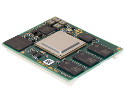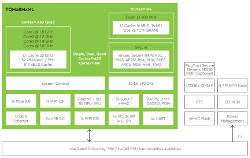Linux-driven modules light up i.MX8X and i.MX8M Mini and Nano
May 6, 2020 — by Eric Brown 1,463 views TQ-Embedded is launching a “TQMa8Xx” and SMARC form-factor “TQMa8XxS” module that run Linux on NXP’s i.MX8X. TQ is also deploying a i.MX8M Mini/Nano based “TQMa8MxML” LGA module.
TQ-Embedded is launching a “TQMa8Xx” and SMARC form-factor “TQMa8XxS” module that run Linux on NXP’s i.MX8X. TQ is also deploying a i.MX8M Mini/Nano based “TQMa8MxML” LGA module.
TQ-Embedded, the embedded unit at Germany-based TQ-Systems, has launched several modules that run Linux on NXP’s i.MX8 processors. The company just announced two new modules — the TQMa8Xx and SMARC 2.1 compatible TQMa8XxS — that run on the low-power i.MX8X. In March, TQ announced a TQMa8MxML module that supports either the i.MX8M Mini or Nano. All three modules will ship on May 15, which TQ says is the date the i.MX8X officially begins volume shipments.


TQMa8Xx (left) and TQMa8XxS
(click images to enlarge)
In March, TQ announced an SBC and box PC based on a dual-core -A72 Layerscape LS1028A. The SBC is based on a TQMLS1028A module we covered in Mar. 2019 that was announced along with modules based on Intel’s Whiskey Lake and NXP’s T1022. In January of this year, TQ announced a module based on NXP’s 16-core -A72 Layerscape LX2160A. We will cover both Layerscape products soon in a separate story.
TQMa8Xx and TQMa8XxS
— ADVERTISEMENT —
The 55 x 44mm TQMa8Xx and 82 x 50mm, SMARC 2.1 form-factor TQMa8XxS are designed for medical devices, HMIs, industrial controllers IIoT gateways, building automation, transport, and robotics. Both modules. which we read about on EENews Embedded, support Linux, with Android and QNX available on request.
NXP’s power-efficient, up to quad-core Cortex-A35 based i.MX8X is clocked to 1.2GHz. TQ supports the Dual, Dual Plus, and Quad Plus models (also referred to as the DualX, DualXPlus, and QuadXPlus). The “Plus” models feature a 4-shader Vivante GT7000Lite GPU while the Dual has a 2-shader GT7000UltraLite. All three processors integrate a 266MHz Cortex-M4 chip and a Tensilica HiFi 4 DSP.
Both the TQMa8Xx and TQMa8XxS support up to 2GB DDR3L with optional ECC support, as well as up to 256MB QSPI NOR flash and up to 64GB eMMC. They both have dual GbE controllers, an RTC, and a temperature sensor.
The modules are available in -25 to 85°C or -40 to 85°C models. They run on 3.3VDC inputs and the TQMa8XxS also offers an optional 3.3V-5.25V input. Typical consumption is listed as 4W.


TQMa8Xx (left) and TQMa8XxS block diagrams
(click images to enlarge)
The key difference between the modules is that the TQMa8XxS SMARC module has a 4K-ready eDP interface whereas the TQMa8Xx offers HD-ready MIPI-DSI. They both offer 2x LVDS and MIPI-CSI.
Almost all the other interfaces are listed as “up to.” While the TQMa8XxS emphasizes displays, the TQMa8X is more attuned to audio, with 2x SPDIF and 4x ESAI. The SMARC module lacks these signals but provides an I2S interface.
They both offer a USB 3.0 OTG interface, and the TQMa8XxS supplies 5x USB 2.0 while the TQMa8Xx has 2x USB 2.0 OTG. The TQMa8X has more serial interfaces with 4x UART and 3x CAN FD. It also has more SPI (4x), I2C (8x), and GPIO (32x) connections. Both provide single SDIO and PCIe interfaces, as well as optional JTAG.
Each module has its own eval kit — the STKa8Xx or STKa8XxS — with the modules loaded with 1GB DDR3L and 8GB eMMC. The boards have a 4GB SD card, dual GbE ports, PCIe, and dual LVDS. Other I/O differs, with varying numbers of serial, CAN FD, USB, and more. There is also a power supply and cables. Starterkit versions add a TQ display kit. A software wiki and extensive documentation are also available.
Other i.MX8X-based modules, which should similarly be shipping in volume within the next few weeks, include Advantech’s ROM-5620 SMARC module, as well as Compulab’s CL-SOM-iMX8X, Kontron’s SMARC-sAMX8X, Congatec’s Qseven-based Conga-QMX8X, F&S’ efus MX8X, Phytec’s phyCORE-i.MX 8X, Variscite’s VAR-SOM-MX8X, and the Toradex Colibri iMX8X and Digi ConnectCore 8X.
TQMa8MxML
The TQMa8MxML has a 38 x 38mm LGA form factor. The module supports both the i.MX8M Mini and similarly up to quad-core -A53, but slightly stripped down i.MX8M Nano (see farther below). Other compute modules that support both SoCs include Variscite’s VAR-SOM-MX8M-MINI and Toradex’s Verdin, among others.


TQMa8MxML and block diagram
(click images to enlarge)
The TQMa8MxML supports all the Mini and Nano core configurations and ships with Linux, with Android on request. You can load up to 4GB LPDDR4 on the i.MX8M Mini and 2GB on the Nano version. You also get up to 64GB eMMC and up to 256MB QSPI NOR flash.
The TQMa8MxML is equipped with a GbE controller, temp sensor, RTC, and optional JTAG. The 5V module offers 4W typical consumption and supports the same temperature ranges as the TQMa8Xx and TQMa8XxS.
Media features include 4-lane MIPI-DSI and -CSI and a rich set of audio features including SPDIF, up to 20x I2S, and up to 8x PDM mic connections. Aside from a single USB 2.0 host interface, all the following I/Os are listed as “up to.” These include 1x or 3x USB 2.0 OTG links, according to conflicting listings, as well as 4x UART, 4x I2C, 3x SPI, 3x SDIO/eMMC, and single QSPI and PCIe 2.0.
An optional STKa8MxML eval kit provides the module loaded with 2GB LPDDR4 and 8GB eMMC. The carrier board ships with a 4GB SD card, as well as 2x USB 2.0 host and single micro-USB OTG 2.0 and GbE ports. Media ports include eDP, LVDS, MIPI-CSI, and audio. There is a mini-PCIe slot with SIM card slot plus a power supply and cables. A Starterkit version adds a display.
NXP’s i.MX8M Mini and i.MX8M Nano SoCs use a more advanced 14LPC FinFET process than the i.MX8M. On the Mini, this results in lower power consumption and higher clock rates for the 1x, 2x, or 4x Cortex-A53 (1.8GHz) and single Cortex-M4 (400MHz) cores. The Mini also provides GCNanoUltra (3D) and GC320 (2D) graphics cores with video acceleration for 1080p60 instead of 4K for the i.MX8M.
The newer, smaller i.MX8M Nano similarly offers up to 4x -A53 cores but tops out at 1.5GHz. The Nano, which is pin-compatible with the Mini, has a Vivante GC7000UL 3D/2D GPU, but no VPU. It does, however, integrate a higher-end, 600MHz Cortex-M7 chip and has an under 2W TDP.
Further information
The TQMa8Xx, TQMa8XxS, and TQMa8MxML are all due to ship May 15, with pricing undisclosed. More information may be found in TQ-Embedded’s TQMa8Xx and TQMa8XxS announcement, as well as its TQMa8Xx and TQMa8XxS product pages.
More on the TQMa8MxMLmay be found in the announcement and product page.
Macnica Americas distributes TQ’s boards in North America, but the product have yet to show up in its catalog.

Please comment here...